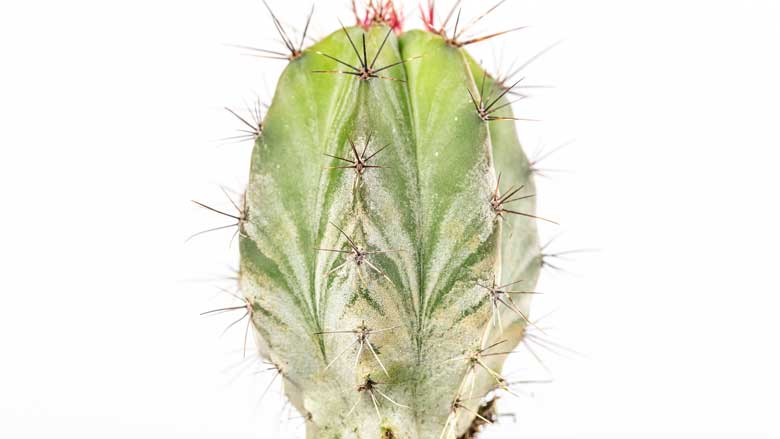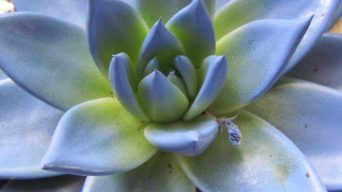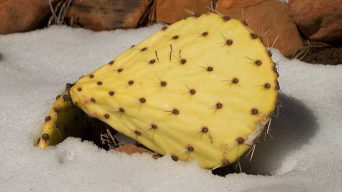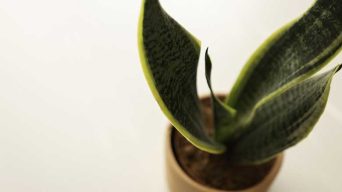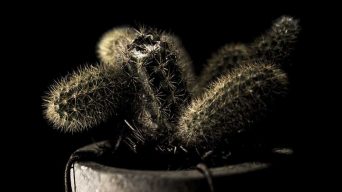As cactus lovers know, cacti are typically green and healthy. But sometimes, they can turn white for no apparent reason.
So if your cactus is turning white, don’t panic!
There are many possible reasons why this may be happening to your cactus plant, and we’ll go through each one in detail so you can figure out what’s wrong with it and how to fix it.
1. Cacti Are Exposed to Cold Temperatures
Cacti are not designed to withstand cold temperatures.
When cacti live in an area where the temperature drops below 50 Fahrenheit, they can turn white because of exposure to frost or ice crystals forming on their needles and other parts.
This is often a temporary condition, but cacti can die if they are exposed to extreme cold for an extended period.
How To Treat Cactus Frost Damage
If cacti are suffering frost damage from long exposure to cold temperatures, the cactus will need a period where it can come back to life in warmer weather before you treat them.
The best thing you can do is move your cactus indoors and give it plenty of water while exposing its roots to warm air near an open window.
You may also want to prune away dead branches so that healthy growth continues unhindered by these areas on the plant.
Provide sunlight but avoid overexposure, potentially burning the plant’s skin (especially ice covering). Be patient, and cacti will recover from frost damage after a few weeks of care.
How To Prevent Frost Damage
If you are worried about your cactus surviving the winter, there are some precautions you can take to prevent it from getting too cold:
- Plant cacti indoors in an area where they will be shielded from direct contact with snow or ice by walls, windowsills, etc.,
- Make sure cacti stay hydrated during colder months so that soil does not become dry and allow for any moisture to escape through cracks in the skin (check under pot’s drainage holes),
- Cover plants’ exposed roots with mulch or other insulating material like leaves or straw bales if the plant is left outside,
- Wrap cacti in burlap or other protective coverings as the days grow colder to help protect cactus from drying out.
2. Cactus Is Under Too Much Sun Exposure
If cacti are placed in a location with too much direct sunlight, they will start to turn white and look crispy.
The cactus is getting sunburned by the UV radiation from the sun, which destroys living cells on its skin.
This causes it to become dehydrated because of all the water evaporating out of its leaves, needles, or spines.
How To Treat Cactus Sunburn
If the cactus is turning white because of sunburn, it will need to be moved into a more shaded location with indirect sunlight.
You may also want to spray the cactus with water every day or two until it feels better, as this can help hydrate its skin and leaves.
Do not apply water or fertilizers because these will only increase the risk of sunburn. This can cause more damage than good.
How To Prevent Cactus Sunburn
If your cactus is turning white, it may be from sunburn.
To prevent this from happening in the future, try to make sure your cacti get enough light but not too much sunlight and that they are given enough water, so their skin does not dry out.
3. Cactus Has Been in a Place That’s Not Well Ventilated or Gets Moldy
When a cactus is in an area without good ventilation, it can start to turn white.
This is because cacti need a lot of airflow to maintain their moisture levels.
If the cactus is in an area that’s not ventilated well, it can start to turn white as the mold starts to grow on its surface.
It may also begin to rot and fall apart.
How To Treat It
If your cactus is turning white, move the cactus to a place with good ventilation or bring it outside on nice days when possible.
Water the cactus well and remove any moldy spots.
It may take some time for the cactus to regain its green color, but as long as there is no mold growing on its surface, then you should be okay.
How To Prevent It
Mold doesn’t grow on cacti that are in a well-ventilated area, so make sure to place your cactus somewhere where it will have good airflow.
Good cactus ventilation can be achieved by either moving the cactus into an open, sunny space or bringing it outside on nice days when possible.
You should also water the cactus regularly and remove any moldy parts of its surface with a brush.
If there is no sign of mold, then you’re doing everything right!
4. Cactus Is Overfed
The cactus may be turning white because it is being overfed with fertilizer. Cacti need to be fertilized very sparingly.
They should only be fertilized once a year.
If you are using too much fertilizer, the chances are high that this is what’s going on.
The cactus leaves will also be yellowing if they’ve been given too many nutrients, which can lead to them falling off due to a lack of chlorophyll.
Leaves may also look sunburned because of their inability to absorb sunlight for photosynthesis anymore.
How To Treat Cactus Overfeeding
If you are overfeeding your cactus, reduce the amount of fertilizer you are using.
You can limit the growth of a cactus by pruning it and making sure it is in the shade.
If you cut off the top parts, it will not grow as high, so that it will need less water and nutrients.
How To Prevent Cactus Overfeeding
To prevent cacti from being overfed, fertilize them once per year with cactus food diluted to half-strength.
You can also use cactus soil mix in place of a potting mix to provide it with cacti nutrients.
5. Cactus Has Been Watered Too Much or Not Enough
If the cactus has been watered too much or not enough, the plant can turn white. This is because cacti require less water than most plants.
Cactus soil should be allowed to dry out between each watering, but some cactus types can survive with little or no water at all.
- If the cactus has been overwatered, it will turn white and start wilting as the moisture evaporates from its leaves. There may be a slimy coating on the surface of the cacti pot if this occurs.
- If cactus has not been watered enough–or hasn’t received any at all–it will have shriveled stems and spines and will turn white.
The cactus may start drooping, looking yellowed, and even drying out before losing its shade completely once it turns all white while exposed to heat.
How To Treat Cactus Overwatering and Underwatering
When faced with an excessively watered cactus, the ideal course of action is to allow the cactus to gradually dry out in a sunny, warm spot.
It is essential to avoid direct sunlight, as cacti need protection from the heat.
When addressing insufficient water for a cactus, it is advisable to irrigate the cactus roots until water freely exits through the drainage holes in the pot.
Then, let the cactus sit for a while before watering again (to ensure the plant receives enough moisture).
Quick fix: Allow the cactus to dry between each watering–or even better- keep an eye on its soil moisture levels so you know when it’s time to water the cactus!
How To Prevent Cactus Overwatering and Underwatering
To avoid these problems with watering, make sure cacti are planted in pots with drainage holes on all sides of the pot’s bottom so water can escape from overwatered soil.
Also, be sure to use a well-draining cactus potting mix, which provides excellent aeration for roots (preventing soggy soil).
Additionally, don’t give cacti a lot of water all at once, and allow excess moisture to dry up before adding more water.
6. Cactus Has Had Cactus Moth (Cactoblastis cactorum)
The cactoblastis cactorum is a moth that causes many cacti to turn white.
The larvae of this bug feed primarily on the tissue under the plant’s skin, which can lead to death or severe deformity.
You can get cactoblastis cactorum by purchasing a plant from someone who has had the disease or through your own propagation.
How To Treat Cactus Moth
If your cactus has this disease, there are two ways you can treat it:
Treatment One:
It would be best to use a cactoblastis cactorum spray to kill the moth. This will not only kill any present cacti but also future generations of cactoblastis cactorum so you can prevent it from happening again.
Treatment Two:
If your plant is severely damaged by cactoblastis cactorum, then cut off all dead branches and get rid of them as soon as possible.
The less material it is for larvae to feed on, the better chances are that they won’t become adults because this will help starve their population.
How To Prevent Cactus Moth
To prevent this pest from reaching your cacti, you should avoid planting cactus near any plants that cactoblastis cactorum is attracted to.
This includes tomatoes and potatoes because the moth has a preference for these sorts of plants.
You should also quarantine new plants for three months in an area without cacti.
Keep all cactus pots being grown indoors away from windows where they could be contaminated with light coming in.
You may also want to use insecticide on the cacti if they have been infested with bugs so far.
7. Cactus Has Been Attacked by Bugs
A white appearance on a cactus is often the result of bugs such as spider mites, aphids, and mealybugs.
These pests insert their eggs into cactus needles, which hatch and produce more of the bugs.
They then secrete a substance called honeydew on cacti leaves that encourages rotting mold to grow.
A cactus attacked by bugs will be covered in white or pink patches where it has been eaten away.
How To Treat Pests Infestation
A cactus that appears white because of infestation from pests can usually be treated if caught early enough.
In order to know when this needs to happen, monitor your cactus for any signs of insects, such as brown or black spots on the leaves and yellowing foliage.
If you see these symptoms, then there is likely some type of pest attacking your cactus.
It will need treatment in order not only to save the plant but also to prevent more bug eggs from hatching and reinfesting other plants in your garden space.
To kill off these harmful insects, make sure to spray the cactus leaves with an insecticidal soap or neem oil.
How To Prevent Pests Infestation
To prevent the infestation of cacti by pests, some precautions can be taken.
First and foremost is keeping cactus plants in a well-lit space where they get plenty of sunlight.
This will help your cactus better resist the effects of any bugs flying around it, which might carry an infesting virus or disease.
Secondly, keep cactus out of humid spaces such as bathrooms or kitchens.
These places often contain other plant life types, which could harbor bacteria on their leaves that can infect cacti through simple contact with them.
Finally, properly water your cactus, so it doesn’t wilt away from dehydration while making sure not to overwater it either.
This is key for having an insect-resistant garden cactus.
8. Cactus Is Being Exposed to Chemicals
A cactus turning white could be due to exposure to chemicals such as bleach, ammonia, etc.
The cactus may have been exposed to chemicals while it was being washed, or the container that you are using to water your cacti in is holding bleach residues or other harmful substances.
How To Treat Chemical Exposure
If cacti have been exposed to chemicals, here are some steps that you can take to help them recover:
- Place the cactus outdoors during the day and bring it inside at night for a few days. This will allow the cactus time to detoxify from any harmful substances and also give it enough light so that photosynthesis can occur.
- Wash surrounding surfaces with warm water and soap or detergent, then rinse off well. This will remove any residual traces of toxic materials hoping they don’t remain on cacti’s leaves too long.
Once these steps have been taken, repeat watering your cactus until you see new growth appear, which indicates recovery.
If, after three months, there’s no new growth, then the cactus could be permanently damaged and may need to be replaced.
How To Prevent Chemical Exposure
Maintain a safe distance from any chemical cleaners and ensure they have sealed tightly away from cacti when not in use.
If possible, remove cacti from an area where there might be lingering fumes and vapors of these toxic materials.
If this isn’t possible, then air out the area after cleaning with fresh outside air as much as possible before bringing cacti back into the space.
9. Cactus Is Rotting
If a cactus has turned brown on the outside and mushy inside, it could be a sign of root rot.
A rotting cactus can turn white because salt buildup creates an environment where bacteria grow well.
Sometimes this cactus will also have root decay which makes it difficult for them to absorb water.
As a result, they start turning dry from the sun or rain exposure, leading to more rotting problems since there isn’t enough moisture in their skin to prevent infection.
How To Treat Cactus Rot
If your cactus turns white because of rotting, then you will want to cut off any damaged parts as soon as possible with pruning shears.
You will also need to remove the cactus from its pot and reduce watering.
This cactus needs repotting in fresh, dry soil that has been treated with fungicide or anti-rot formula.
The cactus should be watered sparingly afterward and then placed back into a brightly lit area for good air circulation.
If you notice cactus white spots after repotting, you’ll need to keep an eye on them until they grow back in color and texture (usually two weeks).
But don’t worry–most cacti will not have any lasting damage from this type of infection if appropriately treated.
How To Prevent Cactus Rot
To prevent cactus rot, you can take a few precautions.
One of these is to avoid over-watering or overwatering your cacti by giving it just the right amount so that its roots never get soggy and start releasing toxins into the plant tissue.
You can also prevent cactus rot by cutting off any dead or decaying parts of the cacti.
10. Cactus Has a Fungal Infection
A cactus turning white could be a sign of cactus erythema resulting from a fungal infection.
This condition typically appears as red spots or raised areas on the cacti’s surface with yellow and brown borders.
The fungus can affect any part of the plant. Still, it usually starts at ground level within reach of water or rain droplets from overhead plants.
It will eventually cause soft patches to form in between joints, where you’ll find more delicate tissues that are susceptible to drying out due to drought conditions.
How To Treat Fungal Infection
If cactus erythema is what you’re seeing, the first step to take is trimming away any diseased areas and then treating them with a fungicide.
The cactus will need to be misted daily and allowed plenty of air movement.
Choose a sheltered location from rain or spray but where the cactus can get some natural light without getting too hot.
How To Prevent Fungal Infection
The best way to prevent cactus erythema from happening in the first place is with good airflow and by being vigilant about water management.
Keep cacti away from sources of standing water and always ensure that they have plenty of air circulation around them at all times.
Remember not to overwater as well because wet soil provides an ideal environment for fungal growth.
Final Thoughts
Cactus turning white is a problem that cacti owners need to take care of.
The exact cause may differ depending on the cactus’ individual situation and location.
Still, there are many ways to treat this issue appropriately.
Please keep in mind that cacti have been around for centuries, and they can withstand these situations with time as long as their needs are met.

